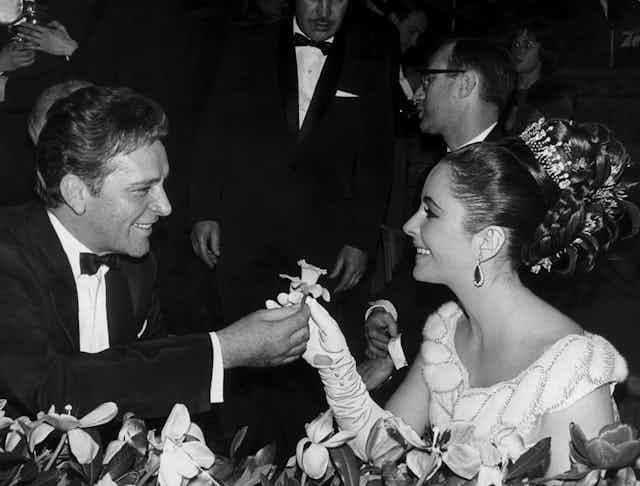Roger Lewis’s biographies are always rich, wayward, engrossing, idiosyncratic and above all obsessive, which seems entirely fitting for evoking the particular qualities of his latest subject – the celebrity couple to end them all, Richard Burton and Elizabeth Taylor.
Lewis’s substantial new book, Erotic Vagrancy: Everything About Richard Burton and Elizabeth Taylor, takes its title from a phrase used in a papal condemnation of the couple when their affair began during the making of 20th Century Fox’s epic 1963 film Cleopatra in Rome. This served to emphasise the atmosphere of notoriety that surrounded Taylor and Burton’s relationship throughout its 20-year duration.
It also suggests the way they represented a new (and to the Vatican, unwelcome) approach to sexual and romantic conduct. Previous marriages were dispensed with in pursuit of this electric, ecstatic new coupling. The media pursued the couple as they criss-crossed the world on private jets and luxury yachts, hoovering up enormous diamonds and other expensive trinkets along the way.

But the vision of love Taylor and Burton represented was far from sweetness and light. Instead, it seems to have been a prolonged struggle of can’t-live-with, can’t-live-without, characterised by drunken arguments and bitter recrimination. The couple’s films then replayed and remixed it for duly fascinated paying cinema customers – most famously in 1966’s Who’s Afraid of Virginia Woolf?
Jet-set celebrity glamour
Lewis suggests the couple were at the vanguard of contemporary celebrity culture, while also taking care to frame them as creatures of their time – members of a long-vanished glamorous jet-set whose 1960s and ’70s haunts have all but disappeared. Lewis describes his undimmed and even growing affection for his subjects in spite of – or perhaps because of – their shameless bad behaviour, from very public fights to unfulfilled charitable promises.

Their love and its emotional maelstrom undoubtedly inflicted enormous harm, on others as well as themselves. And its narcissistic showiness, writ in priceless jewels and ardent gestures across a global stage, was vulgar. However, Lewis offers an incisive deconstruction and defence of vulgarity as a human quality, reframing the couple’s outrageous extravagance as a generosity of spirit, living large and leaning into their role as collective fantasy figures.
And he loves their films, especially the egregious flops and off-kilter experiments like Boom! (1968), Hammersmith Is Out (1972) and Divorce His / Divorce Hers (1973), discerning in their bizarre contours a fever dream of the couple’s romance.
Myths and spells
Burton’s journey was the more extraordinary of the two: from Welsh working-class impoverishment to full movie mega-stardom, by way of his prodigious charisma as a young actor. Lewis alleges Burton’s schoolmaster svengali and adoptive father had less than honourable intentions towards his ward, but he was the facilitator of Burton’s longed-for exit from the valleys.

No wonder Burton nursed a longstanding fascination with the Faust legend, feeling he had sold his soul to the devil to attain worldly glory, including “the face that launched a thousand ships” in the form of the beautiful Taylor – who played the Helen of Troy role opposite her husband’s Faustus in Burton’s 1967 screen adaptation of Christopher Marlowe’s play.
Lewis appears to identify slightly more with the Welshman’s dark moods than he does the dramas of the divine Elizabeth, a pampered princess and movie star from childhood. He is in thrall to the idea of Taylor as witch, casting a spell over Burton.
Lewis uses Kingsley Amis’s phrasing to characterise the star as “a wrapped-up-in-herself female” and wonders aloud if women are “generally less rational, more instinctive and immediate, than your males”. To which one can only respond: hogwash. Hogwash that depends on completely ignoring what an irrational mystic Burton seems to have been, continually invoking his alchemical mythic origin as a figure created in the bowels of the Welsh earth.

This is not a feminist book – there is a broadside against “rubbishy academic tracts by frightening feminists” in the author’s opening remarks on the existing Burton-Taylor literature. Lewis acknowledges the physical abuse Taylor suffered at the hands of her first husband, Nicky Hilton, while she was still in her teens, but quibbles over the dates of the pregnancy she says she miscarried after being beaten by him – not a good look.
He goes on to suggest that many of the actress’s subsequent health problems were psychosomatic or self-inflicted, or just simple malingering. But thankfully, these potentially misogynistic notes are counterbalanced by other moments of empathy and insight. There is full-throated celebration of Taylor, especially as she aged and gained weight, as an unruly woman who refused to adhere to the template of feminine probity and modesty. Her greed – for love, adventure, sex, food, excitement, wealth, beauty – is not censured but saluted.
Erotic Vagrancy is packed with details that not only make you pause and gasp, but which penetrate the core of what it means to be famous, or infamous, and in love.

And its wit makes it sparkle and glitter like one of Taylor’s extravagant diamonds – coruscating in the true sense of the word. The research and writing has clearly been a labour of love for Lewis, and the result is a lovingly all-encompassing celebrity biography which interrogates both celebrity and biography as concepts.
But it does so with levity and personality, always wearing its learning and its eloquence lightly. To invoke the title of a film starring one of Taylor’s pals, Rock Hudson, this book is the result of a “magnificent obsession” with Richard Burton and Elizabeth Taylor, and all the better for it.

Looking for something good? Cut through the noise with a carefully curated selection of the latest releases, live events and exhibitions, straight to your inbox every fortnight, on Fridays. Sign up here.

